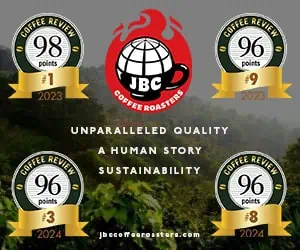Bunn My Café
The Bunn My Café uses paper pods, the same dimension pods as the Senseo brewer. Bunn only brands the brewing units; it does not sell Bunn-branded coffee and no license is required to produce Bunn-compatible paper pods. This hands-off, open format approach makes the Bunn program unique among single-serve systems.
Proprietary capsule design: No
Approximate cost per serving early 2011: $.56 – $.62
Brewer cost early 2011: $99.99 – $439.95
Weight of ground coffee per serving, in grams: ~ 10.0 – 12.0 g
Volume per serving: User determines volume up to a maximum of 16 oz.; pour-over system
Tested volume per serving: 6 oz.
Pressure-assisted extraction: Yes
Range of available coffees: As of early 2011 relatively limited
Ratings of eleven compatible coffees tested (brewed in 6-ounce servings): High 88, Low 72, Average 80
Also produces espresso-style coffee: No
Incorporates hot frothed milk solution: No
Refillable pods available: Yes; Ecopad (refillable) and Perfect Pod Coffee Pod Maker
Model tested: My Café MC
Design notes: Clean, no frills
Footprint and general size: Medium
Pros:
Pour-over system; the volume of water you pour into the top of the unit displaces (after the brew button is pressed) the same volume of brewing water through the pod and into the cup.
Sophisticated brewing procedure, with pre-infusion and a pulse brew option that mildly intensifies intensity and bitterness, characteristics which some coffee drinkers enjoy and celebrate. Generally obtains a good extraction from paper pods.
Cons:
At this writing a relatively limited number of coffees are available in compatible pods, and based on our tests the quality (and distinction) of these coffees is not particularly impressive.
The unit we tested produced mildly off-tasting water, probably from contact with plastic parts, although this off-taste (mildly chemical, astringent) seldom seemed strong enough to impact the flavor of the final beverage.
Notes:
Designed to produce an American-style brewed coffee: no espresso or hot chocolate capabilities. Produces tea from compatible pods.
Compatible paper pods and their spent grounds are completely compostable, but the protective packaging for the pods is not.
Keurig
Uses only K-cups, a proprietary capsule design. Other capsules or pods cannot be used in Keurig brewers, and K-cups cannot be used in other designs of single-serve brewers.
Approximate cost per K-cup early 2011: $.62 – $.81
Brewer cost early 2011: $80.00 – $249.00
Weight of ground coffee per serving, in grams: 9.0 – 12.0 g
Volume per serving: 6 – 12 oz.
Tested volume per serving: 6 oz.
Pressure-assisted extraction: Yes, but very mild
Range of available coffees: Very large selection and growing
Ratings of twelve K-cup coffees tested (brewed in 6-ounce servings): High 89, Low 84, Average 87
Also produces espresso-style coffee: No
Incorporates hot frothed milk solution: No
Refillable pods available: Yes; refillable My K-Cup unit available at www.keurig.com
Model tested: B70 Platinum
Design notes for tested model: Backlit aquamarine
Footprint and general size of model tested: Largish. Less expensive models are more compact.
Pros:
A very large and growing range of coffees is available in K-cups, and the quality of these coffees is generally good to very good, considerably better than the quality of coffees available for all other tested systems except the Nespresso.
Generous-sized water reservoir.
Cons:
The unit we tested produced very mildly off-tasting water, probably from contact with plastic parts, although the off taste never appeared pronounced enough to adversely affect the flavor of the final beverage.
Notes:
Designed to produce an American-style brewed coffee. No espresso capability, although K-cup versions of tea and hot chocolate beverages are available.
K-cups are not recyclable.
Nespresso
For this month’s reviews we tested Nespresso capsules ONLY in the context of American-style coffee, in this case the 4-ounce beverage Nespresso calls “lungo.”
Uses Nespresso “Grands Crus” capsules. Other capsules or pods cannot be used in Nespresso units, and Nespresso capsules cannot be used in other designs of single-serve brewers.
Approximate cost per capsule early 2011: $.55 – $.62
Brewer cost early 2011: $199.00 – $799.95
Weight of ground coffee per serving, in grams: ~ 6 g
Volume per serving: 1.25 and 4 oz. factory default setting; manual override available
Tested volume per serving for this month’s reviews: 4 oz.
Pressure-assisted extraction: Yes, fully pressurized espresso extraction at 19 atmospheres
Range of available coffees: At present limited to 16 blends. Nespresso-compatible capsules from other roasting companies are beginning to appear in Europe as patents expire.
Ratings of 6 Nespresso coffees tested (all brewed in ”lungo” 4-ounce servings, not as espresso): High 89, Low 85, Average 87
Also produces espresso-style coffee: Yes; specifically designed for espresso-style coffee
Incorporates hot frothed milk solution: Yes, at additional cost
Refillable pods available: No
Model tested: CitiZ
Design notes: Retro locomotive for the tested CitiZ unit; quite attractive. Other units situate more in the Jetsons moderne to reticent box modes.
Footprint and general size: Compact for the tested unit; other, more expensive units are larger.
Pros:
The sixteen Nespresso “Grands Cru” blends are distinctive in character and high in quality. On the other hand, there are only sixteen, and only four are designed for “lungo,” a 4-ounce black coffee, though the other eight, designed for espresso brewing, make plausible short black coffees as well, particularly the three origin-specific blends from Colombia, Brazil and India.
The Nespresso produced virtually no off taste in the brewing water, even when run straight out of the box.
The Nespresso produces quite attractive espresso beverages; see our reviews at Convenience First: Espresso Pods and Capsules.
Cons:
Coffee lovers have only sixteen options from which to choose, although they are excellent options.
Nespresso brewing units are relatively expensive.
Notes:
The Nespresso system is specifically designed to produce only espresso beverages and short, European-style black coffee.
The metal Nespresso capsules are not recyclable, although capsule recycling collection programs have been developed for eight countries, so far all in Europe, with the intention of extending these programs to additional countries.
Senseo
The Senseo is designed to use its own line of paper pods, though pods that fit the Bunn My Café also fit the Senseo.
Proprietary capsule design: No
Approximate cost per serving early 2011: $.29 – $.34
Brewer cost early 2011: $70.00 – $140.00
Weight of ground coffee per serving, in grams: 7 g
Volume per serving: 4 – 8 oz.
Tested volume per serving: 5 oz.
Pressure-assisted extraction: Yes
Range of available coffees: As of early 2011 relatively limited
Ratings of seven Senseo-brand paper-pod coffees tested (brewed in 5-ounce servings): High 85, Low 76, Average 81
Also produces espresso-style coffee: No
Incorporates hot frothed milk solution: No
Refillable pods available: Yes; Ecopad (refillable) and Perfect Pod Coffee Pod Maker
Model tested: Senseo (entry level model)
Design notes: Jetsons moderne
Footprint and general size: Compact
Pros:
Least costly single-serve system, both for brewers and the Senseo brand pods.
Incorporates an adaptor that permits use of two stacked pods to produce taller (8-ounce) beverage sizes.
Cons:
At this writing only a relatively limited number of coffees are available in Senseo-compatible pods, and the quality (and distinction) of these coffees is only fair.
Small water reservoir
The tested unit produced off-tasting water, even after repeated use. The water quality adversely affected the flavor of several of the tested coffees.
Notes:
Designed to produce an American-style brewed coffee. Tea pods and a special tea-pod adaptor are also available. No espresso or hot chocolate capabilities.
Compatible paper pods and their spent grounds are completely compostable, although the bulk packaging for the pods is neither compostable nor recyclable. Nevertheless, the combination of completely compostable spent pods and low-waste bulk packaging arguably makes the Senseo program the most environmentally friendly of the single-serve systems at point of brewing.
Tassimo
Uses only Tassimo brand T Discs. Other single-serve capsules or pods cannot be used in Tassimo units, and Tassimo T Discs cannot be used in other brands of single-serve brewers.
Approximate cost per serving early 2011: $.38 -$.92
Brewer cost early 2011: $130 – $200
Weight of ground coffee per serving, in grams: ~ 6.9 – 14.5 g
Volume per serving: Default depending on beverage 4 – 8 oz. Manual override available
Tested volume per serving: 4 – 6 oz.
Pressure-assisted extraction: Yes
Range of available coffees: As of early 2011 quite limited
Ratings of ten compatible coffees tested (brewed in 4- or 6-ounce servings): High 87, Low 79, Average 84
Also produces espresso-style coffee: Yes
Incorporates hot frothed milk solution: Yes
Refillable pods available: No
Model tested: Tassimo Home Brewing System
Design notes: No-nonsense modern
Footprint and general size: Medium
Pros:
Most versatile of single-serve units (produces brewed coffee, espresso beverages, teas, and a hot chocolate), although the newly introduced Nestlé Dolce Gusto system is designed to match the Tassimo in its all-purpose, beverage-center ambitions.
Little to no off-taste in the brewing water of the tested unit.
Cons:
At this writing a very limited number of coffees are available in compatible T Discs. Furthermore, aside from the Starbucks blends, the quality (and distinction) of these coffees is generally low. To add to this discouraging picture, the Starbucks offerings almost certainly will disappear from the Tassimo repertoire soon, given that Starbucks has dissolved its relationship with Kraft, the owner of the Tassimo brand. At that point the only available coffees for the Tassimo will be Kraft brands, with the Starbucks blends replaced by presumably similar style blends from the Kraft unit Gevalia.
Notes:
So far as we could determine from a search of the Tassimo website, T Discs are not recyclable.












